BSM777 Research Methods: Millennial Travel Risk Perception Study
VerifiedAdded on 2023/04/26
|61
|17596
|309
Report
AI Summary
This research proposal (BSM777) investigates the risk perceptions that influence millennial travel decisions. It explores three key areas: risk perception of the tourist destination, strategies for mitigating those risks, and the impact of destination image on travel attitudes. The study aims to identify the variables that determine whether millennials choose to travel to a particular destination, considering both obvious and subconscious factors. The literature review draws on tourism and psychology research related to risk perception, mitigation, and destination image. The methodology employs inductive reasoning, a critical realism philosophy, and a mixed-methods data collection approach. The report includes sections on data analysis, findings, and a conclusion, offering insights for destination marketers and expanding knowledge of risk and decision-making in the tourism sector. Desklib offers similar solved assignments for students.
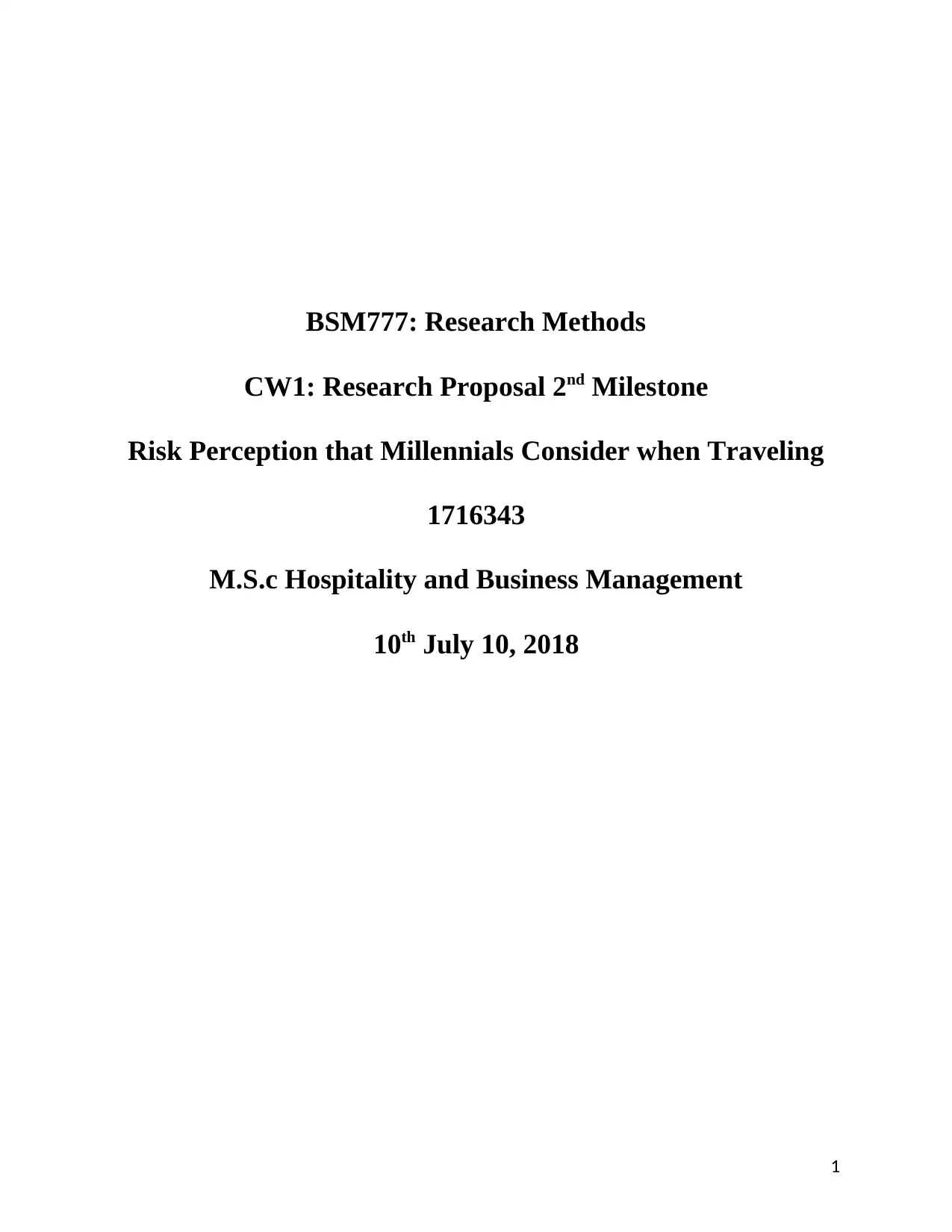
BSM777: Research Methods
CW1: Research Proposal 2nd Milestone
Risk Perception that Millennials Consider when Traveling
1716343
M.S.c Hospitality and Business Management
10th July 10, 2018
1
CW1: Research Proposal 2nd Milestone
Risk Perception that Millennials Consider when Traveling
1716343
M.S.c Hospitality and Business Management
10th July 10, 2018
1
Paraphrase This Document
Need a fresh take? Get an instant paraphrase of this document with our AI Paraphraser
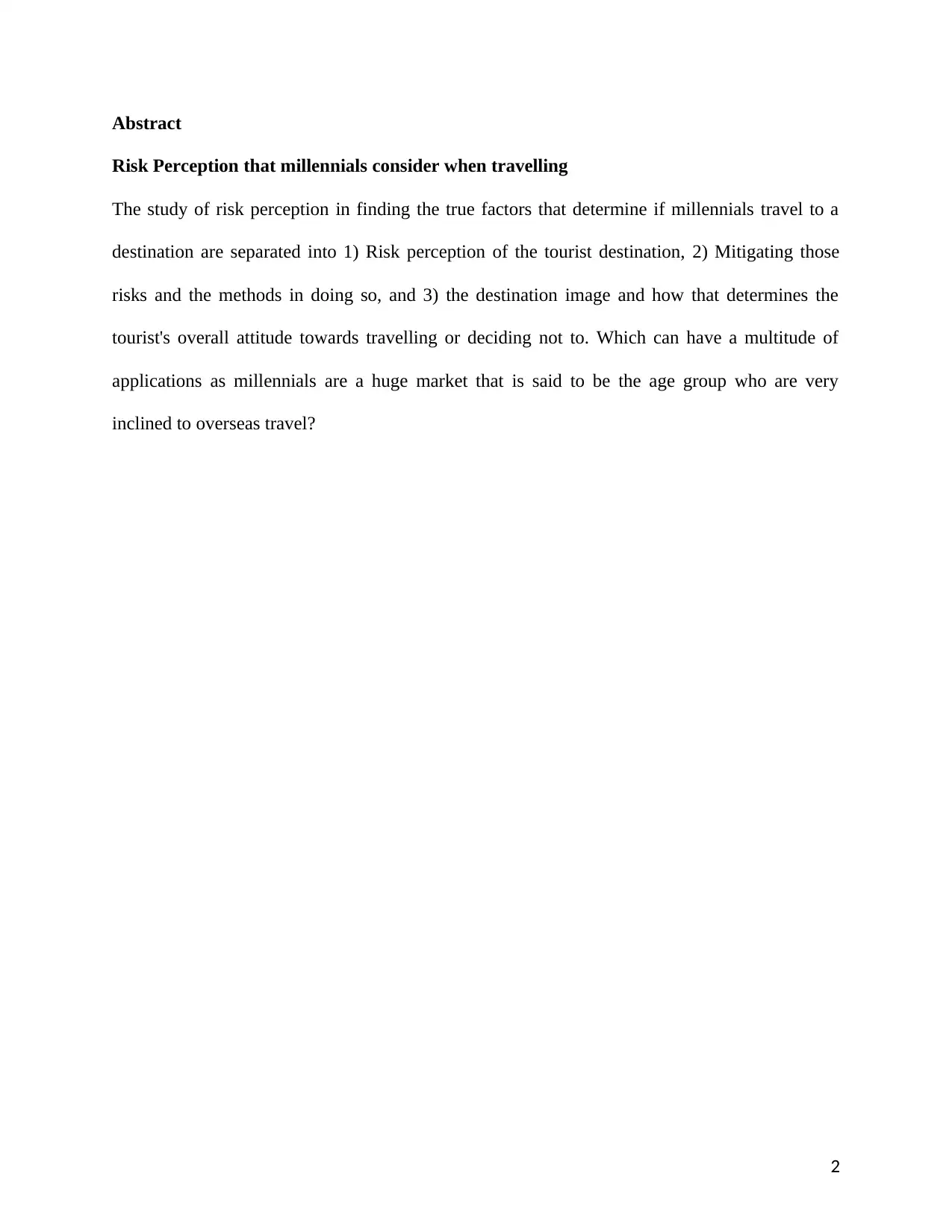
Abstract
Risk Perception that millennials consider when travelling
The study of risk perception in finding the true factors that determine if millennials travel to a
destination are separated into 1) Risk perception of the tourist destination, 2) Mitigating those
risks and the methods in doing so, and 3) the destination image and how that determines the
tourist's overall attitude towards travelling or deciding not to. Which can have a multitude of
applications as millennials are a huge market that is said to be the age group who are very
inclined to overseas travel?
2
Risk Perception that millennials consider when travelling
The study of risk perception in finding the true factors that determine if millennials travel to a
destination are separated into 1) Risk perception of the tourist destination, 2) Mitigating those
risks and the methods in doing so, and 3) the destination image and how that determines the
tourist's overall attitude towards travelling or deciding not to. Which can have a multitude of
applications as millennials are a huge market that is said to be the age group who are very
inclined to overseas travel?
2
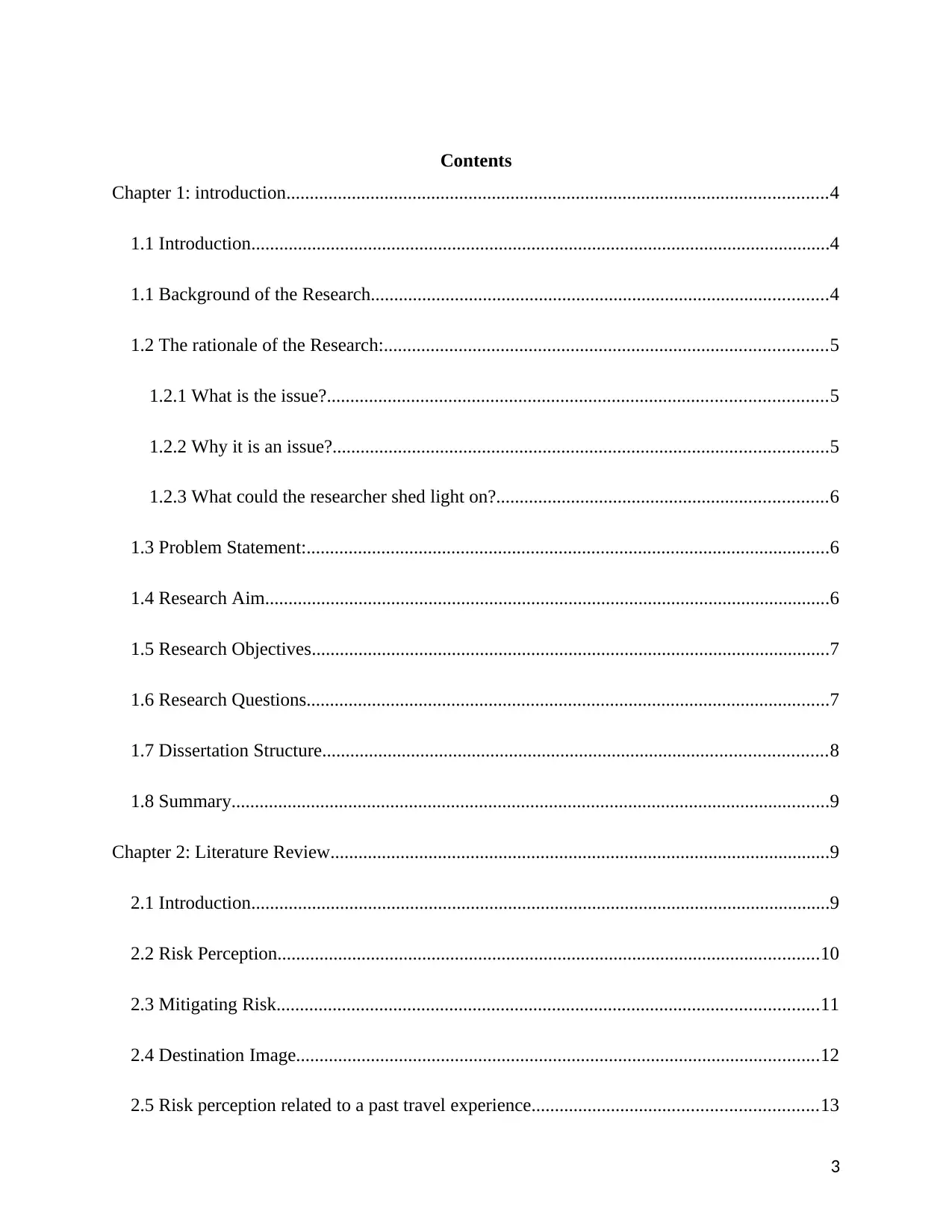
Contents
Chapter 1: introduction....................................................................................................................4
1.1 Introduction............................................................................................................................4
1.1 Background of the Research..................................................................................................4
1.2 The rationale of the Research:...............................................................................................5
1.2.1 What is the issue?...........................................................................................................5
1.2.2 Why it is an issue?..........................................................................................................5
1.2.3 What could the researcher shed light on?.......................................................................6
1.3 Problem Statement:................................................................................................................6
1.4 Research Aim.........................................................................................................................6
1.5 Research Objectives...............................................................................................................7
1.6 Research Questions................................................................................................................7
1.7 Dissertation Structure............................................................................................................8
1.8 Summary................................................................................................................................9
Chapter 2: Literature Review...........................................................................................................9
2.1 Introduction............................................................................................................................9
2.2 Risk Perception....................................................................................................................10
2.3 Mitigating Risk....................................................................................................................11
2.4 Destination Image................................................................................................................12
2.5 Risk perception related to a past travel experience.............................................................13
3
Chapter 1: introduction....................................................................................................................4
1.1 Introduction............................................................................................................................4
1.1 Background of the Research..................................................................................................4
1.2 The rationale of the Research:...............................................................................................5
1.2.1 What is the issue?...........................................................................................................5
1.2.2 Why it is an issue?..........................................................................................................5
1.2.3 What could the researcher shed light on?.......................................................................6
1.3 Problem Statement:................................................................................................................6
1.4 Research Aim.........................................................................................................................6
1.5 Research Objectives...............................................................................................................7
1.6 Research Questions................................................................................................................7
1.7 Dissertation Structure............................................................................................................8
1.8 Summary................................................................................................................................9
Chapter 2: Literature Review...........................................................................................................9
2.1 Introduction............................................................................................................................9
2.2 Risk Perception....................................................................................................................10
2.3 Mitigating Risk....................................................................................................................11
2.4 Destination Image................................................................................................................12
2.5 Risk perception related to a past travel experience.............................................................13
3
⊘ This is a preview!⊘
Do you want full access?
Subscribe today to unlock all pages.

Trusted by 1+ million students worldwide
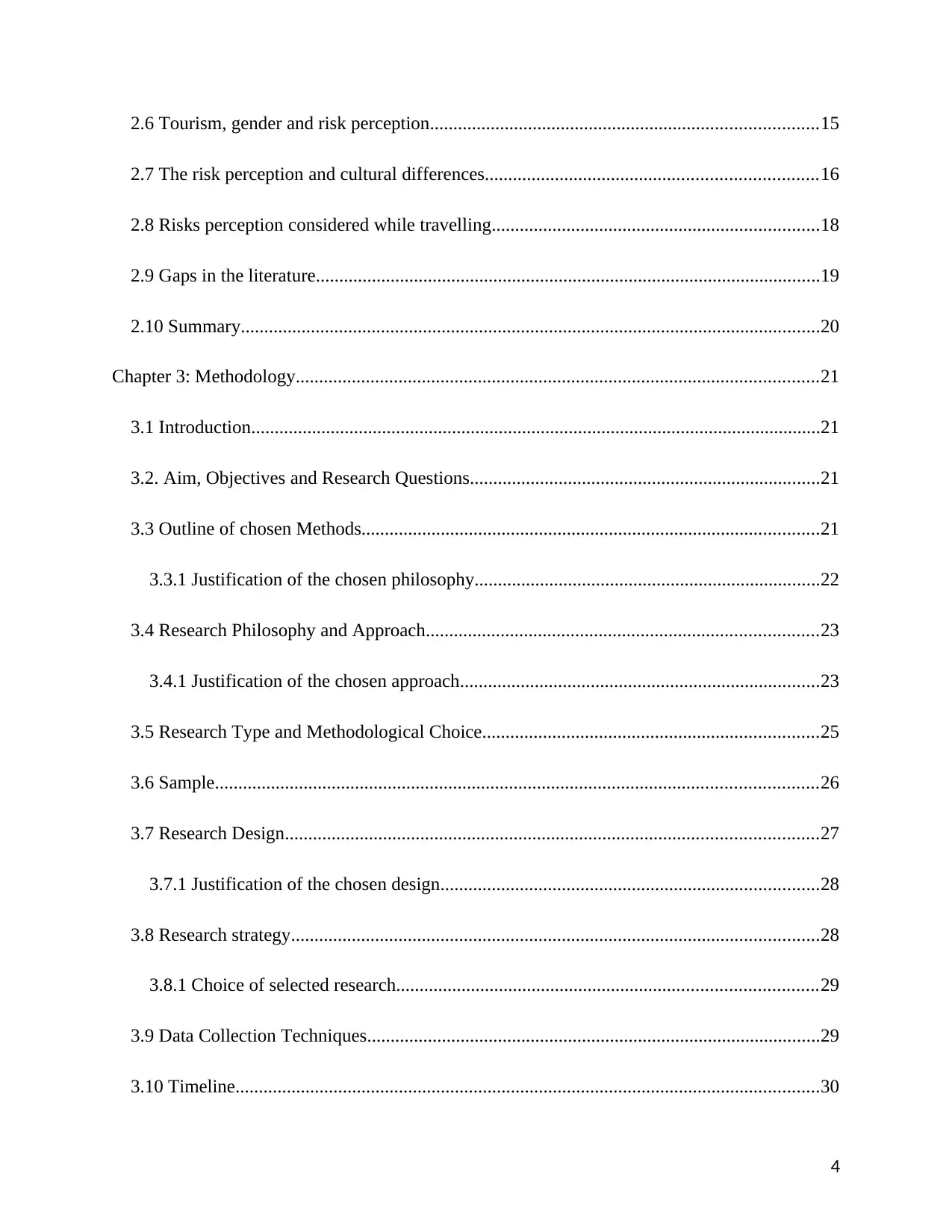
2.6 Tourism, gender and risk perception...................................................................................15
2.7 The risk perception and cultural differences.......................................................................16
2.8 Risks perception considered while travelling......................................................................18
2.9 Gaps in the literature............................................................................................................19
2.10 Summary............................................................................................................................20
Chapter 3: Methodology................................................................................................................21
3.1 Introduction..........................................................................................................................21
3.2. Aim, Objectives and Research Questions...........................................................................21
3.3 Outline of chosen Methods..................................................................................................21
3.3.1 Justification of the chosen philosophy..........................................................................22
3.4 Research Philosophy and Approach....................................................................................23
3.4.1 Justification of the chosen approach.............................................................................23
3.5 Research Type and Methodological Choice........................................................................25
3.6 Sample.................................................................................................................................26
3.7 Research Design..................................................................................................................27
3.7.1 Justification of the chosen design.................................................................................28
3.8 Research strategy.................................................................................................................28
3.8.1 Choice of selected research..........................................................................................29
3.9 Data Collection Techniques.................................................................................................29
3.10 Timeline.............................................................................................................................30
4
2.7 The risk perception and cultural differences.......................................................................16
2.8 Risks perception considered while travelling......................................................................18
2.9 Gaps in the literature............................................................................................................19
2.10 Summary............................................................................................................................20
Chapter 3: Methodology................................................................................................................21
3.1 Introduction..........................................................................................................................21
3.2. Aim, Objectives and Research Questions...........................................................................21
3.3 Outline of chosen Methods..................................................................................................21
3.3.1 Justification of the chosen philosophy..........................................................................22
3.4 Research Philosophy and Approach....................................................................................23
3.4.1 Justification of the chosen approach.............................................................................23
3.5 Research Type and Methodological Choice........................................................................25
3.6 Sample.................................................................................................................................26
3.7 Research Design..................................................................................................................27
3.7.1 Justification of the chosen design.................................................................................28
3.8 Research strategy.................................................................................................................28
3.8.1 Choice of selected research..........................................................................................29
3.9 Data Collection Techniques.................................................................................................29
3.10 Timeline.............................................................................................................................30
4
Paraphrase This Document
Need a fresh take? Get an instant paraphrase of this document with our AI Paraphraser
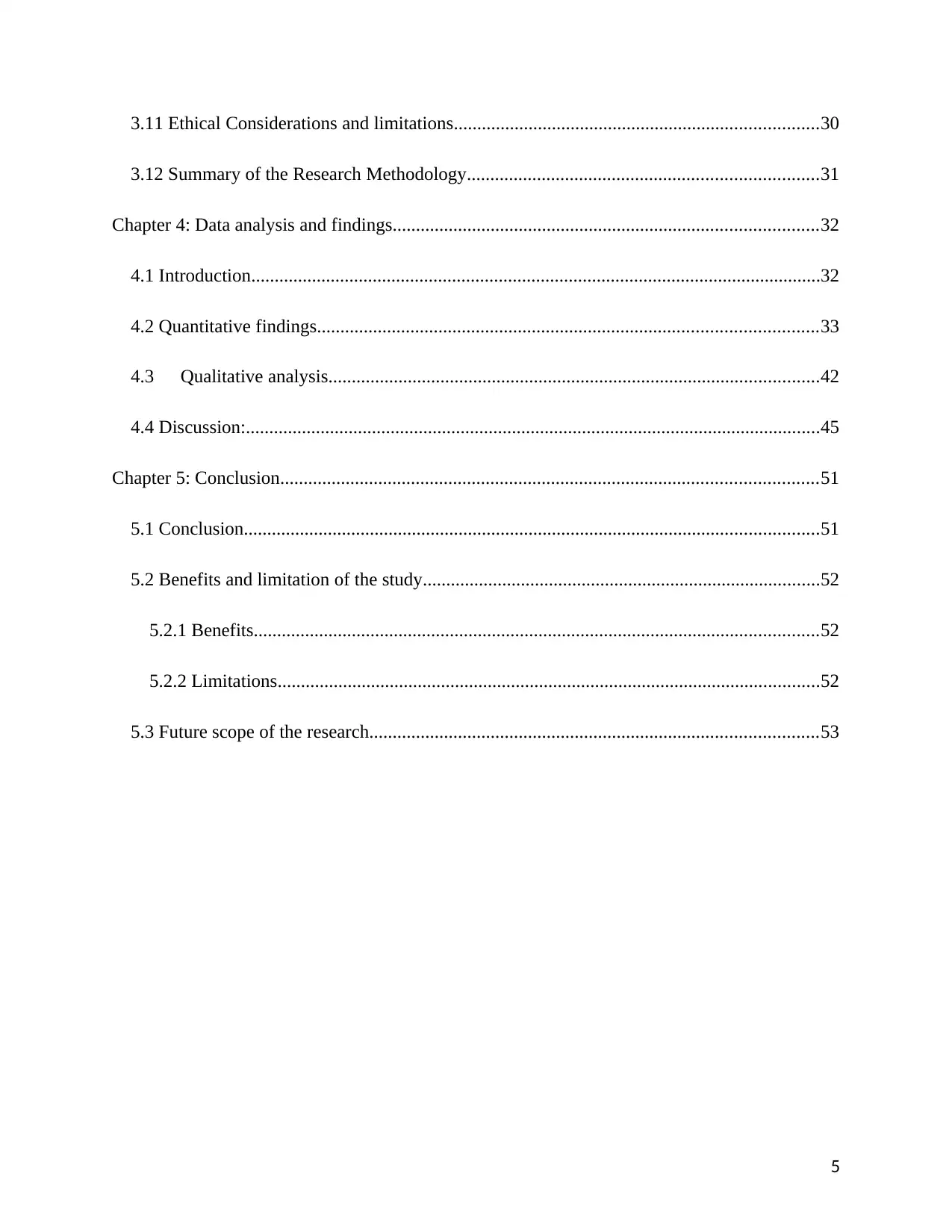
3.11 Ethical Considerations and limitations..............................................................................30
3.12 Summary of the Research Methodology...........................................................................31
Chapter 4: Data analysis and findings...........................................................................................32
4.1 Introduction..........................................................................................................................32
4.2 Quantitative findings...........................................................................................................33
4.3 Qualitative analysis.........................................................................................................42
4.4 Discussion:...........................................................................................................................45
Chapter 5: Conclusion...................................................................................................................51
5.1 Conclusion...........................................................................................................................51
5.2 Benefits and limitation of the study.....................................................................................52
5.2.1 Benefits.........................................................................................................................52
5.2.2 Limitations....................................................................................................................52
5.3 Future scope of the research................................................................................................53
5
3.12 Summary of the Research Methodology...........................................................................31
Chapter 4: Data analysis and findings...........................................................................................32
4.1 Introduction..........................................................................................................................32
4.2 Quantitative findings...........................................................................................................33
4.3 Qualitative analysis.........................................................................................................42
4.4 Discussion:...........................................................................................................................45
Chapter 5: Conclusion...................................................................................................................51
5.1 Conclusion...........................................................................................................................51
5.2 Benefits and limitation of the study.....................................................................................52
5.2.1 Benefits.........................................................................................................................52
5.2.2 Limitations....................................................................................................................52
5.3 Future scope of the research................................................................................................53
5
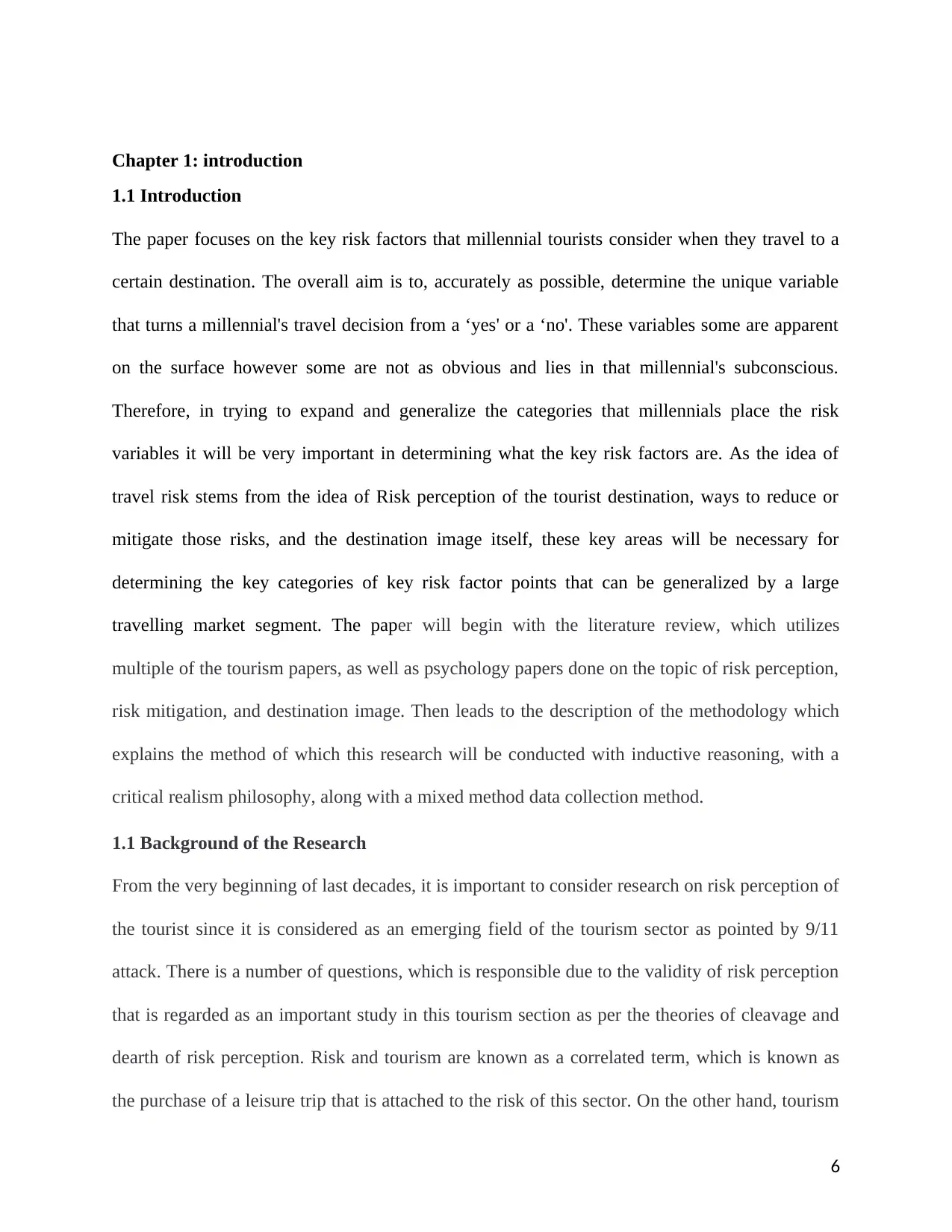
Chapter 1: introduction
1.1 Introduction
The paper focuses on the key risk factors that millennial tourists consider when they travel to a
certain destination. The overall aim is to, accurately as possible, determine the unique variable
that turns a millennial's travel decision from a ‘yes' or a ‘no'. These variables some are apparent
on the surface however some are not as obvious and lies in that millennial's subconscious.
Therefore, in trying to expand and generalize the categories that millennials place the risk
variables it will be very important in determining what the key risk factors are. As the idea of
travel risk stems from the idea of Risk perception of the tourist destination, ways to reduce or
mitigate those risks, and the destination image itself, these key areas will be necessary for
determining the key categories of key risk factor points that can be generalized by a large
travelling market segment. The paper will begin with the literature review, which utilizes
multiple of the tourism papers, as well as psychology papers done on the topic of risk perception,
risk mitigation, and destination image. Then leads to the description of the methodology which
explains the method of which this research will be conducted with inductive reasoning, with a
critical realism philosophy, along with a mixed method data collection method.
1.1 Background of the Research
From the very beginning of last decades, it is important to consider research on risk perception of
the tourist since it is considered as an emerging field of the tourism sector as pointed by 9/11
attack. There is a number of questions, which is responsible due to the validity of risk perception
that is regarded as an important study in this tourism section as per the theories of cleavage and
dearth of risk perception. Risk and tourism are known as a correlated term, which is known as
the purchase of a leisure trip that is attached to the risk of this sector. On the other hand, tourism
6
1.1 Introduction
The paper focuses on the key risk factors that millennial tourists consider when they travel to a
certain destination. The overall aim is to, accurately as possible, determine the unique variable
that turns a millennial's travel decision from a ‘yes' or a ‘no'. These variables some are apparent
on the surface however some are not as obvious and lies in that millennial's subconscious.
Therefore, in trying to expand and generalize the categories that millennials place the risk
variables it will be very important in determining what the key risk factors are. As the idea of
travel risk stems from the idea of Risk perception of the tourist destination, ways to reduce or
mitigate those risks, and the destination image itself, these key areas will be necessary for
determining the key categories of key risk factor points that can be generalized by a large
travelling market segment. The paper will begin with the literature review, which utilizes
multiple of the tourism papers, as well as psychology papers done on the topic of risk perception,
risk mitigation, and destination image. Then leads to the description of the methodology which
explains the method of which this research will be conducted with inductive reasoning, with a
critical realism philosophy, along with a mixed method data collection method.
1.1 Background of the Research
From the very beginning of last decades, it is important to consider research on risk perception of
the tourist since it is considered as an emerging field of the tourism sector as pointed by 9/11
attack. There is a number of questions, which is responsible due to the validity of risk perception
that is regarded as an important study in this tourism section as per the theories of cleavage and
dearth of risk perception. Risk and tourism are known as a correlated term, which is known as
the purchase of a leisure trip that is attached to the risk of this sector. On the other hand, tourism
6
⊘ This is a preview!⊘
Do you want full access?
Subscribe today to unlock all pages.

Trusted by 1+ million students worldwide
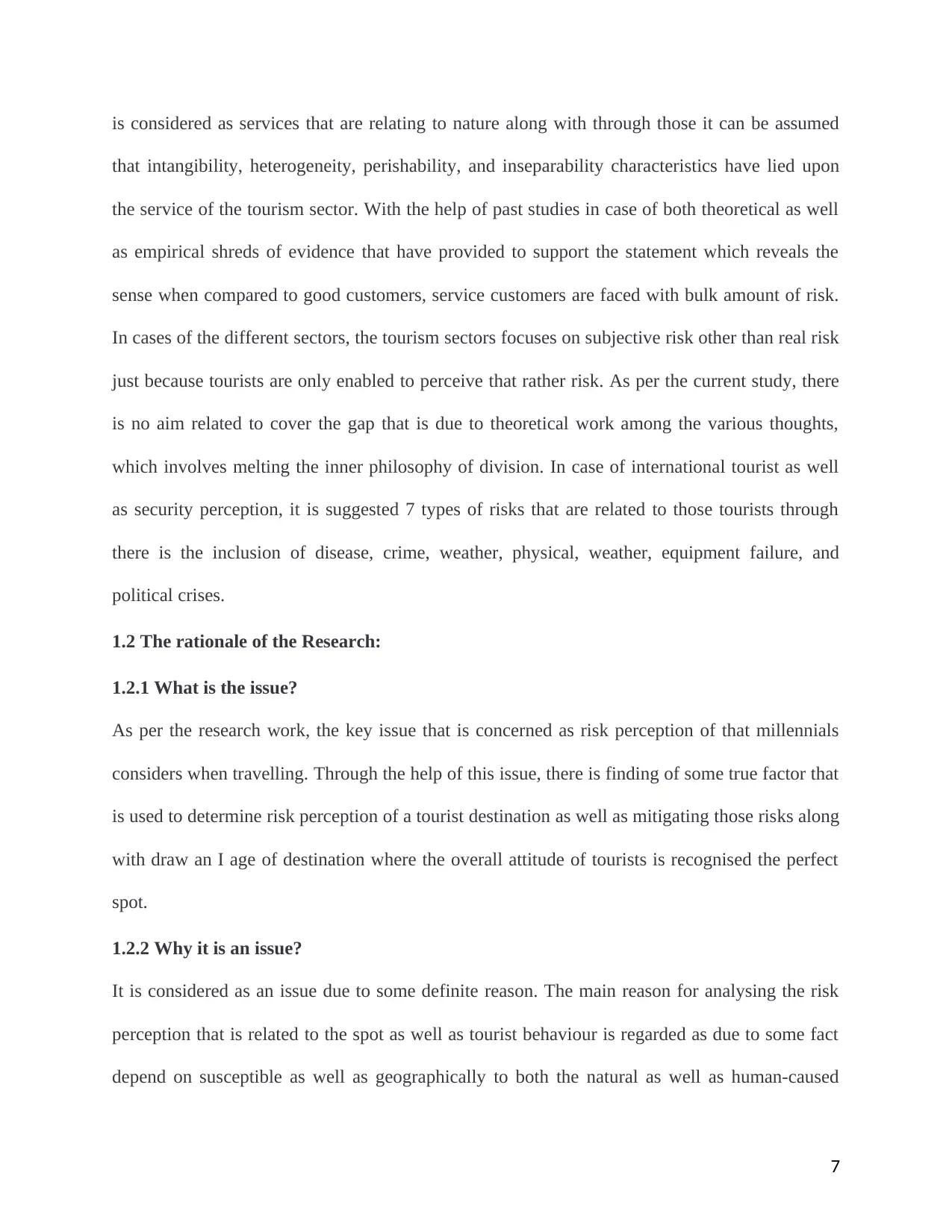
is considered as services that are relating to nature along with through those it can be assumed
that intangibility, heterogeneity, perishability, and inseparability characteristics have lied upon
the service of the tourism sector. With the help of past studies in case of both theoretical as well
as empirical shreds of evidence that have provided to support the statement which reveals the
sense when compared to good customers, service customers are faced with bulk amount of risk.
In cases of the different sectors, the tourism sectors focuses on subjective risk other than real risk
just because tourists are only enabled to perceive that rather risk. As per the current study, there
is no aim related to cover the gap that is due to theoretical work among the various thoughts,
which involves melting the inner philosophy of division. In case of international tourist as well
as security perception, it is suggested 7 types of risks that are related to those tourists through
there is the inclusion of disease, crime, weather, physical, weather, equipment failure, and
political crises.
1.2 The rationale of the Research:
1.2.1 What is the issue?
As per the research work, the key issue that is concerned as risk perception of that millennials
considers when travelling. Through the help of this issue, there is finding of some true factor that
is used to determine risk perception of a tourist destination as well as mitigating those risks along
with draw an I age of destination where the overall attitude of tourists is recognised the perfect
spot.
1.2.2 Why it is an issue?
It is considered as an issue due to some definite reason. The main reason for analysing the risk
perception that is related to the spot as well as tourist behaviour is regarded as due to some fact
depend on susceptible as well as geographically to both the natural as well as human-caused
7
that intangibility, heterogeneity, perishability, and inseparability characteristics have lied upon
the service of the tourism sector. With the help of past studies in case of both theoretical as well
as empirical shreds of evidence that have provided to support the statement which reveals the
sense when compared to good customers, service customers are faced with bulk amount of risk.
In cases of the different sectors, the tourism sectors focuses on subjective risk other than real risk
just because tourists are only enabled to perceive that rather risk. As per the current study, there
is no aim related to cover the gap that is due to theoretical work among the various thoughts,
which involves melting the inner philosophy of division. In case of international tourist as well
as security perception, it is suggested 7 types of risks that are related to those tourists through
there is the inclusion of disease, crime, weather, physical, weather, equipment failure, and
political crises.
1.2 The rationale of the Research:
1.2.1 What is the issue?
As per the research work, the key issue that is concerned as risk perception of that millennials
considers when travelling. Through the help of this issue, there is finding of some true factor that
is used to determine risk perception of a tourist destination as well as mitigating those risks along
with draw an I age of destination where the overall attitude of tourists is recognised the perfect
spot.
1.2.2 Why it is an issue?
It is considered as an issue due to some definite reason. The main reason for analysing the risk
perception that is related to the spot as well as tourist behaviour is regarded as due to some fact
depend on susceptible as well as geographically to both the natural as well as human-caused
7
Paraphrase This Document
Need a fresh take? Get an instant paraphrase of this document with our AI Paraphraser
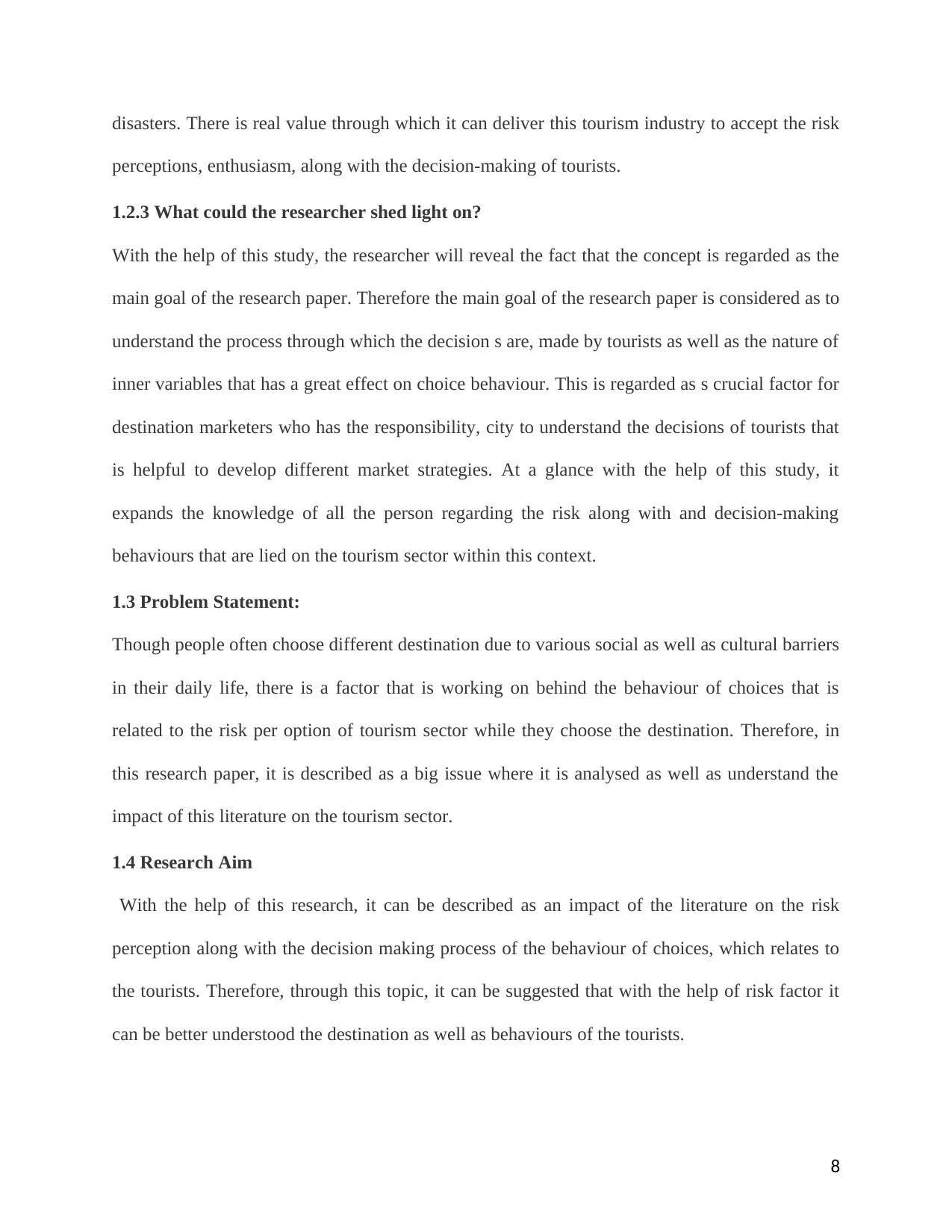
disasters. There is real value through which it can deliver this tourism industry to accept the risk
perceptions, enthusiasm, along with the decision-making of tourists.
1.2.3 What could the researcher shed light on?
With the help of this study, the researcher will reveal the fact that the concept is regarded as the
main goal of the research paper. Therefore the main goal of the research paper is considered as to
understand the process through which the decision s are, made by tourists as well as the nature of
inner variables that has a great effect on choice behaviour. This is regarded as s crucial factor for
destination marketers who has the responsibility, city to understand the decisions of tourists that
is helpful to develop different market strategies. At a glance with the help of this study, it
expands the knowledge of all the person regarding the risk along with and decision-making
behaviours that are lied on the tourism sector within this context.
1.3 Problem Statement:
Though people often choose different destination due to various social as well as cultural barriers
in their daily life, there is a factor that is working on behind the behaviour of choices that is
related to the risk per option of tourism sector while they choose the destination. Therefore, in
this research paper, it is described as a big issue where it is analysed as well as understand the
impact of this literature on the tourism sector.
1.4 Research Aim
With the help of this research, it can be described as an impact of the literature on the risk
perception along with the decision making process of the behaviour of choices, which relates to
the tourists. Therefore, through this topic, it can be suggested that with the help of risk factor it
can be better understood the destination as well as behaviours of the tourists.
8
perceptions, enthusiasm, along with the decision-making of tourists.
1.2.3 What could the researcher shed light on?
With the help of this study, the researcher will reveal the fact that the concept is regarded as the
main goal of the research paper. Therefore the main goal of the research paper is considered as to
understand the process through which the decision s are, made by tourists as well as the nature of
inner variables that has a great effect on choice behaviour. This is regarded as s crucial factor for
destination marketers who has the responsibility, city to understand the decisions of tourists that
is helpful to develop different market strategies. At a glance with the help of this study, it
expands the knowledge of all the person regarding the risk along with and decision-making
behaviours that are lied on the tourism sector within this context.
1.3 Problem Statement:
Though people often choose different destination due to various social as well as cultural barriers
in their daily life, there is a factor that is working on behind the behaviour of choices that is
related to the risk per option of tourism sector while they choose the destination. Therefore, in
this research paper, it is described as a big issue where it is analysed as well as understand the
impact of this literature on the tourism sector.
1.4 Research Aim
With the help of this research, it can be described as an impact of the literature on the risk
perception along with the decision making process of the behaviour of choices, which relates to
the tourists. Therefore, through this topic, it can be suggested that with the help of risk factor it
can be better understood the destination as well as behaviours of the tourists.
8
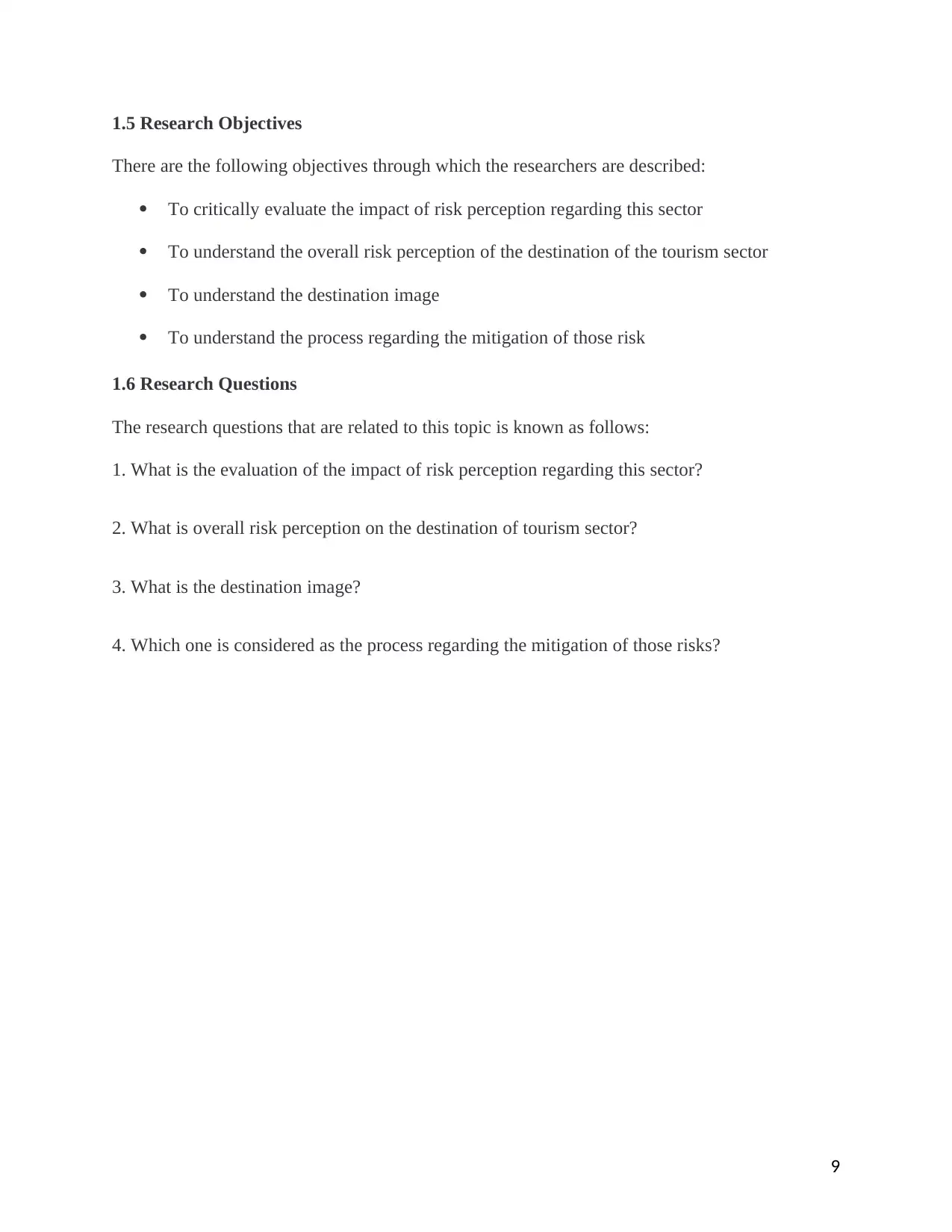
1.5 Research Objectives
There are the following objectives through which the researchers are described:
To critically evaluate the impact of risk perception regarding this sector
To understand the overall risk perception of the destination of the tourism sector
To understand the destination image
To understand the process regarding the mitigation of those risk
1.6 Research Questions
The research questions that are related to this topic is known as follows:
1. What is the evaluation of the impact of risk perception regarding this sector?
2. What is overall risk perception on the destination of tourism sector?
3. What is the destination image?
4. Which one is considered as the process regarding the mitigation of those risks?
9
There are the following objectives through which the researchers are described:
To critically evaluate the impact of risk perception regarding this sector
To understand the overall risk perception of the destination of the tourism sector
To understand the destination image
To understand the process regarding the mitigation of those risk
1.6 Research Questions
The research questions that are related to this topic is known as follows:
1. What is the evaluation of the impact of risk perception regarding this sector?
2. What is overall risk perception on the destination of tourism sector?
3. What is the destination image?
4. Which one is considered as the process regarding the mitigation of those risks?
9
⊘ This is a preview!⊘
Do you want full access?
Subscribe today to unlock all pages.

Trusted by 1+ million students worldwide
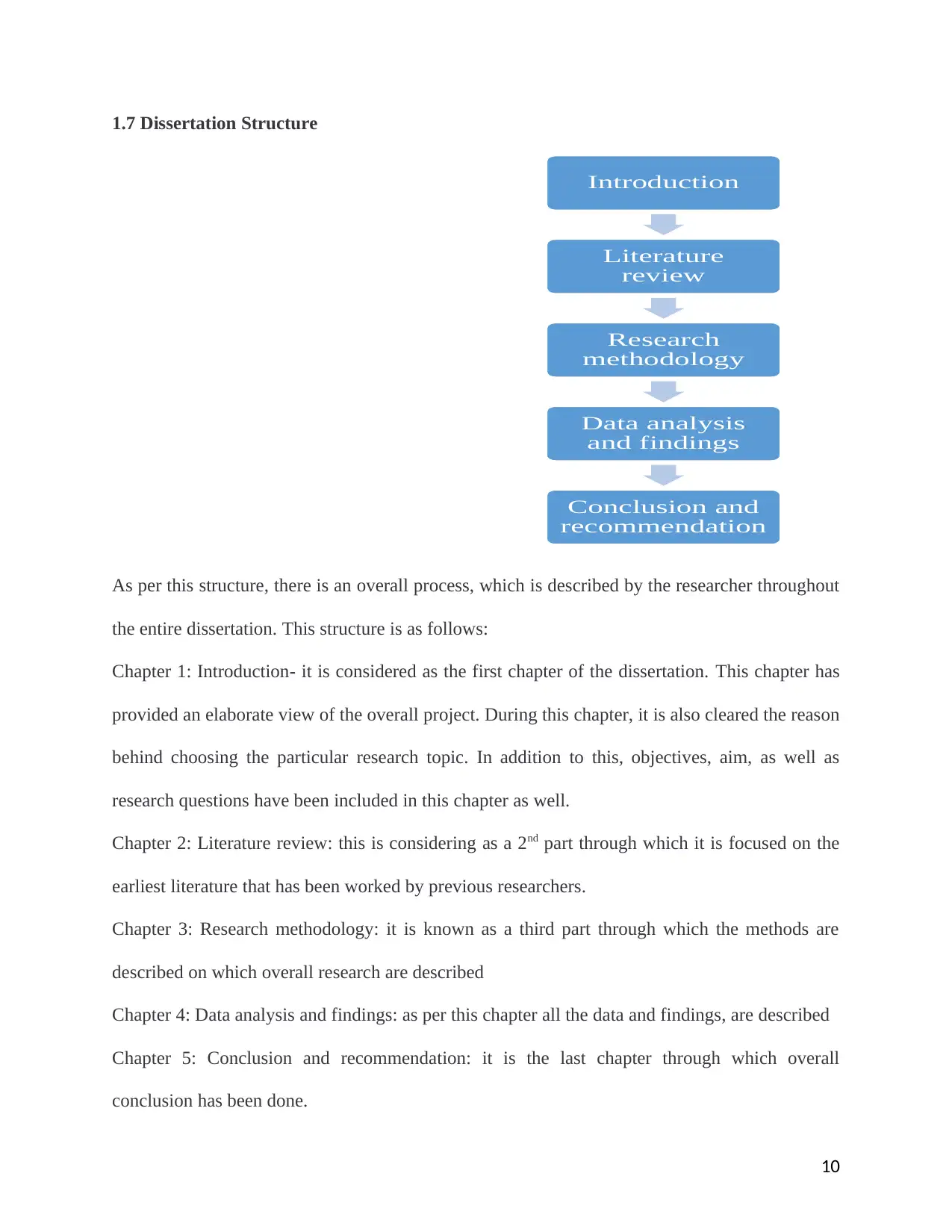
1.7 Dissertation Structure
As per this structure, there is an overall process, which is described by the researcher throughout
the entire dissertation. This structure is as follows:
Chapter 1: Introduction- it is considered as the first chapter of the dissertation. This chapter has
provided an elaborate view of the overall project. During this chapter, it is also cleared the reason
behind choosing the particular research topic. In addition to this, objectives, aim, as well as
research questions have been included in this chapter as well.
Chapter 2: Literature review: this is considering as a 2nd part through which it is focused on the
earliest literature that has been worked by previous researchers.
Chapter 3: Research methodology: it is known as a third part through which the methods are
described on which overall research are described
Chapter 4: Data analysis and findings: as per this chapter all the data and findings, are described
Chapter 5: Conclusion and recommendation: it is the last chapter through which overall
conclusion has been done.
Introduction
Literature
review
Research
methodology
Data analysis
and findings
Conclusion and
recommendation
10
As per this structure, there is an overall process, which is described by the researcher throughout
the entire dissertation. This structure is as follows:
Chapter 1: Introduction- it is considered as the first chapter of the dissertation. This chapter has
provided an elaborate view of the overall project. During this chapter, it is also cleared the reason
behind choosing the particular research topic. In addition to this, objectives, aim, as well as
research questions have been included in this chapter as well.
Chapter 2: Literature review: this is considering as a 2nd part through which it is focused on the
earliest literature that has been worked by previous researchers.
Chapter 3: Research methodology: it is known as a third part through which the methods are
described on which overall research are described
Chapter 4: Data analysis and findings: as per this chapter all the data and findings, are described
Chapter 5: Conclusion and recommendation: it is the last chapter through which overall
conclusion has been done.
Introduction
Literature
review
Research
methodology
Data analysis
and findings
Conclusion and
recommendation
10
Paraphrase This Document
Need a fresh take? Get an instant paraphrase of this document with our AI Paraphraser
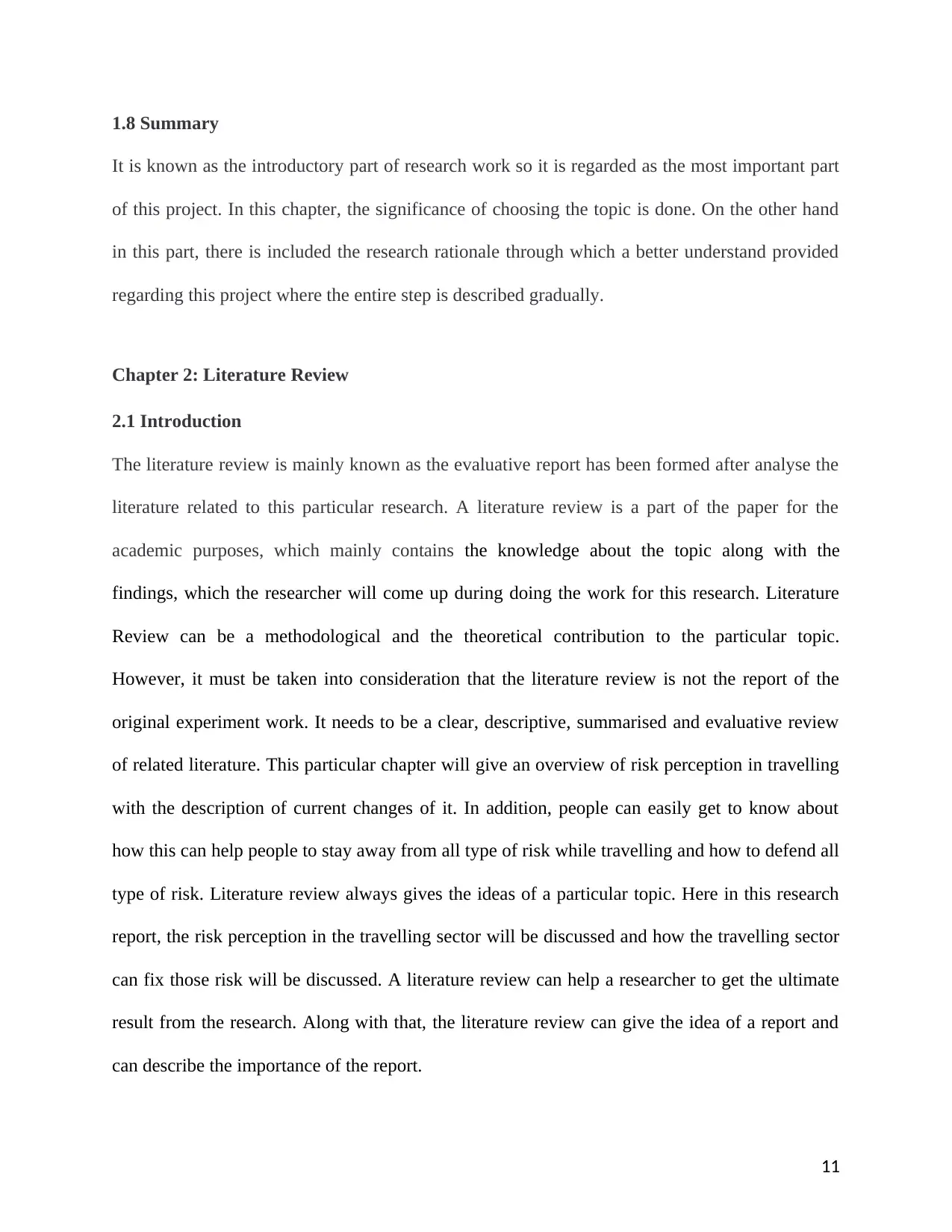
1.8 Summary
It is known as the introductory part of research work so it is regarded as the most important part
of this project. In this chapter, the significance of choosing the topic is done. On the other hand
in this part, there is included the research rationale through which a better understand provided
regarding this project where the entire step is described gradually.
Chapter 2: Literature Review
2.1 Introduction
The literature review is mainly known as the evaluative report has been formed after analyse the
literature related to this particular research. A literature review is a part of the paper for the
academic purposes, which mainly contains the knowledge about the topic along with the
findings, which the researcher will come up during doing the work for this research. Literature
Review can be a methodological and the theoretical contribution to the particular topic.
However, it must be taken into consideration that the literature review is not the report of the
original experiment work. It needs to be a clear, descriptive, summarised and evaluative review
of related literature. This particular chapter will give an overview of risk perception in travelling
with the description of current changes of it. In addition, people can easily get to know about
how this can help people to stay away from all type of risk while travelling and how to defend all
type of risk. Literature review always gives the ideas of a particular topic. Here in this research
report, the risk perception in the travelling sector will be discussed and how the travelling sector
can fix those risk will be discussed. A literature review can help a researcher to get the ultimate
result from the research. Along with that, the literature review can give the idea of a report and
can describe the importance of the report.
11
It is known as the introductory part of research work so it is regarded as the most important part
of this project. In this chapter, the significance of choosing the topic is done. On the other hand
in this part, there is included the research rationale through which a better understand provided
regarding this project where the entire step is described gradually.
Chapter 2: Literature Review
2.1 Introduction
The literature review is mainly known as the evaluative report has been formed after analyse the
literature related to this particular research. A literature review is a part of the paper for the
academic purposes, which mainly contains the knowledge about the topic along with the
findings, which the researcher will come up during doing the work for this research. Literature
Review can be a methodological and the theoretical contribution to the particular topic.
However, it must be taken into consideration that the literature review is not the report of the
original experiment work. It needs to be a clear, descriptive, summarised and evaluative review
of related literature. This particular chapter will give an overview of risk perception in travelling
with the description of current changes of it. In addition, people can easily get to know about
how this can help people to stay away from all type of risk while travelling and how to defend all
type of risk. Literature review always gives the ideas of a particular topic. Here in this research
report, the risk perception in the travelling sector will be discussed and how the travelling sector
can fix those risk will be discussed. A literature review can help a researcher to get the ultimate
result from the research. Along with that, the literature review can give the idea of a report and
can describe the importance of the report.
11
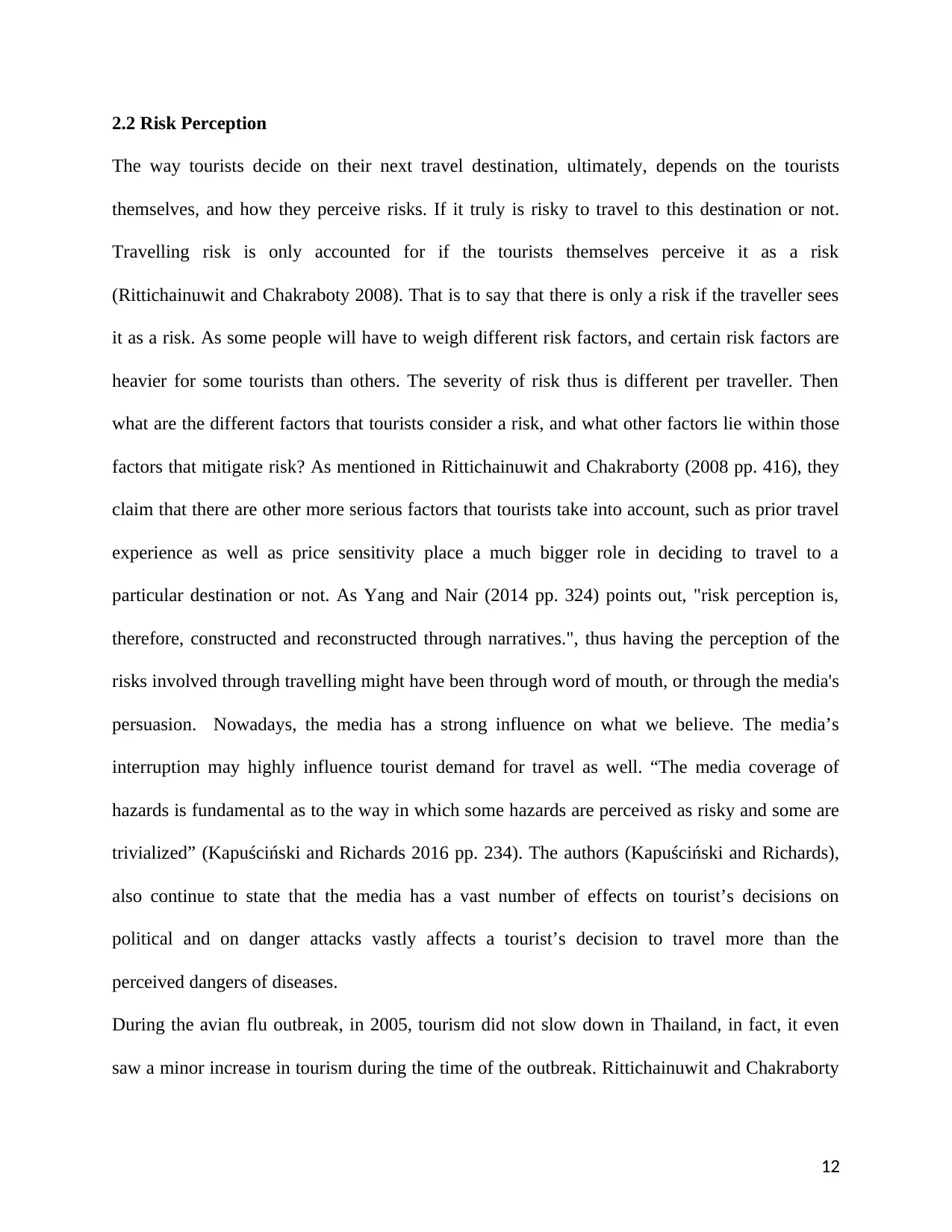
2.2 Risk Perception
The way tourists decide on their next travel destination, ultimately, depends on the tourists
themselves, and how they perceive risks. If it truly is risky to travel to this destination or not.
Travelling risk is only accounted for if the tourists themselves perceive it as a risk
(Rittichainuwit and Chakraboty 2008). That is to say that there is only a risk if the traveller sees
it as a risk. As some people will have to weigh different risk factors, and certain risk factors are
heavier for some tourists than others. The severity of risk thus is different per traveller. Then
what are the different factors that tourists consider a risk, and what other factors lie within those
factors that mitigate risk? As mentioned in Rittichainuwit and Chakraborty (2008 pp. 416), they
claim that there are other more serious factors that tourists take into account, such as prior travel
experience as well as price sensitivity place a much bigger role in deciding to travel to a
particular destination or not. As Yang and Nair (2014 pp. 324) points out, "risk perception is,
therefore, constructed and reconstructed through narratives.", thus having the perception of the
risks involved through travelling might have been through word of mouth, or through the media's
persuasion. Nowadays, the media has a strong influence on what we believe. The media’s
interruption may highly influence tourist demand for travel as well. “The media coverage of
hazards is fundamental as to the way in which some hazards are perceived as risky and some are
trivialized” (Kapuściński and Richards 2016 pp. 234). The authors (Kapuściński and Richards),
also continue to state that the media has a vast number of effects on tourist’s decisions on
political and on danger attacks vastly affects a tourist’s decision to travel more than the
perceived dangers of diseases.
During the avian flu outbreak, in 2005, tourism did not slow down in Thailand, in fact, it even
saw a minor increase in tourism during the time of the outbreak. Rittichainuwit and Chakraborty
12
The way tourists decide on their next travel destination, ultimately, depends on the tourists
themselves, and how they perceive risks. If it truly is risky to travel to this destination or not.
Travelling risk is only accounted for if the tourists themselves perceive it as a risk
(Rittichainuwit and Chakraboty 2008). That is to say that there is only a risk if the traveller sees
it as a risk. As some people will have to weigh different risk factors, and certain risk factors are
heavier for some tourists than others. The severity of risk thus is different per traveller. Then
what are the different factors that tourists consider a risk, and what other factors lie within those
factors that mitigate risk? As mentioned in Rittichainuwit and Chakraborty (2008 pp. 416), they
claim that there are other more serious factors that tourists take into account, such as prior travel
experience as well as price sensitivity place a much bigger role in deciding to travel to a
particular destination or not. As Yang and Nair (2014 pp. 324) points out, "risk perception is,
therefore, constructed and reconstructed through narratives.", thus having the perception of the
risks involved through travelling might have been through word of mouth, or through the media's
persuasion. Nowadays, the media has a strong influence on what we believe. The media’s
interruption may highly influence tourist demand for travel as well. “The media coverage of
hazards is fundamental as to the way in which some hazards are perceived as risky and some are
trivialized” (Kapuściński and Richards 2016 pp. 234). The authors (Kapuściński and Richards),
also continue to state that the media has a vast number of effects on tourist’s decisions on
political and on danger attacks vastly affects a tourist’s decision to travel more than the
perceived dangers of diseases.
During the avian flu outbreak, in 2005, tourism did not slow down in Thailand, in fact, it even
saw a minor increase in tourism during the time of the outbreak. Rittichainuwit and Chakraborty
12
⊘ This is a preview!⊘
Do you want full access?
Subscribe today to unlock all pages.

Trusted by 1+ million students worldwide
1 out of 61
Related Documents
Your All-in-One AI-Powered Toolkit for Academic Success.
+13062052269
info@desklib.com
Available 24*7 on WhatsApp / Email
![[object Object]](/_next/static/media/star-bottom.7253800d.svg)
Unlock your academic potential
Copyright © 2020–2025 A2Z Services. All Rights Reserved. Developed and managed by ZUCOL.





